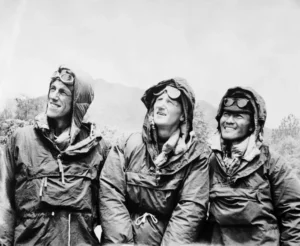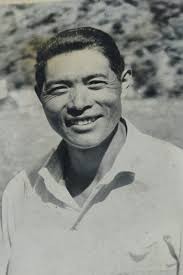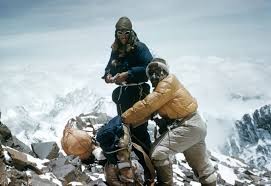TOUGH AND CHEERFUL
Born in 1933, in the Nepalese village of Namche Bazaar in the foothills of the Himalayas, his real name was Ang Phurba – but his mother always called him ‘Kanchha’.
He never knew when his birthday was, but he was born in the Year of the Rooster in the Tibetan Zodiac Calendar.

In 1900, his grandfather had come to the area as a follower of a Tibetan monk and had survived by growing potatoes and foraging from the forest.
Kanchha’s father had been a mountaineer. He had been involved in a failed attempt by Swiss climbers, to conquer Mount Everest from the Tibetan side, a few years earlier.
It was on this trip that his father met, and became friends with, Sherpa Tenzing Norgay.
His village was a poor and isolated area. There were no roads connecting it to the outside world, no schools or medical facilities – and there was no tourism. Consequently, Kanchha was illiterate throughout his life. The only writing he could manage was signing his name in English.
As a small boy (and into his teenage years), Kanchha made a living by growing and selling potatoes in neighbouring Tibet – as well as herding yak. He would trade home-grown corn for sheep’s wool, having to walk miles to do this. He frequently moved across the borders of Nepal, Tibet and India.

Kanchha had an entrepreneurial spirit. He started buying sugar in India and trading it for salt in Tibet.
He once carried thirty kilos of paper over the Nepalese Chinese border.
It was in Nepal that he discovered the Bhote Kukur (the Himalayan Sheepdog) and started to breed and sell them.

Years later, Kanchha’s son said of his father’s upbringing, “His lifestyle was difficult. They had to wait for a festival to get any rice. They had to rely on shamans if someone got sick.”
Whilst herding yaks, Kanchha met some sherpas who had been part of the previous failed Swiss expedition to conquer Everest. He noted that they were extremely well-dressed compared to him. He realised there was more money to be made in mountaineering than in subsistence farming.
It was on a trip to Darjeeling in India, with some friends, that Kanchha was finally persuaded to train as a mountaineer.
Kanchha walked with two friends for four days to reach the training camp. He was accepted; his friends were not.
Soon afterwards, Kanchha began working with foreign trekkers.
In 1953, they heard there was a great expedition led by John Hunt and Edmund Hillary, hoping to climb Mount Everest. Sherpa Tenzing Norgay was to be the lead porter throughout the project.

Hunt claimed they were going to, “Knock the bastard off.”
Kanchha’s father wrote him a testimonial, and he walked eight hours to meet Tenzing.
For a while, Kanchha worked in Tenzing’s house whilst the latter prepared for the trip. He carried water, did the laundry and worked in the kitchen.
Kanchha had proved himself capable of hard work, so was taken on by the expedition, aged just nineteen years old.

He had never seen westerners before. “The English – they had round eyes, yellow hair, and Hillary – he was so tall.”

The expedition employed twenty sherpas, four hundred porters and sixty yaks.
Sherpas were paid a daily rate of eight Nepalese rupees (about £1.30).
As the 35-strong team moved towards Mount Everest they had to wade through knee-deep snow.

The expedition created a new style of mountaineering by establishing six camps along the route. “No-one was really aware of establishing camps on the way to Base Camp.”
The trek to the base camp took two weeks. “Everyone walked because there weren’t any roads, no motor vehicles, no planes.”
Kanchha described the trek as arduous but joyous.
Kanchha’s main job was rope carrier, although he was also responsible for the cooking stoves and the kerosene used to light them. His pack weighed fifty pounds.
As they climbed higher up the South Col of Mount Everest, Kanchha started carrying all John Hunt’s personal equipment. Hunt gave him the nickname ‘Tough and Cheerful’.

Part-way up the mountain, most of the sherpas went on strike. They were extremely frightened by the task ahead of them.
Edmund Hillary and Sherpa Tenzing persuaded them to go on. “They cooked us tea and gave us some snacks. Some sherpa’s feet were very cold, and so Tenzing rubbed them to warm them up…Tenzing, he was a very strong man, but also a very kind man for his workers.”
The higher they climbed, the harder Kanchha found it to breathe, but he refused to take oxygen. However, he was enraptured by what he saw. “I walked around and looked at everything. It was incredible. I looked down and I saw so many glaciers. I could see Tibet and the Rongbuk glacier.”

Kanchha was one of just three sherpas chosen to climb to the last camp below the summit of the mountain – at 7,900 metres. He followed Hillary’s footsteps right up the mountain.
However, he did not climb to the top. This was left to Edmund Hillary and Sherpa Tenzing Norgay. “I still wonder how they figured out the way up to the summit…To me, it looked impossible from where I stood.”

Instead, Kanchha heard about the achievement on the radio used by the climbers. It was the 29th May 1953. He said, “Everyone was so happy. We were hugging and kissing each other. I was so happy. I couldn’t believe any of this.”

To this day, nobody knows who reached the summit of Mont Everest first – Hillary or Tenzing. Until their dying day, neither man revealed who it was (even to their own families). Kanchha said, “They were a team.”
They reunited with Hillary and Tenzing at Camp Two (just 6,400 metres). “We all gathered at Camp Two but there was no alcohol, so we celebrated with tea and snacks. We then collected whatever we could and carried it to base camp.”

On the way back down Everest, the team left a lot of things behind. Kanchha ruefully lamented, “So much food we left on the mountain.”
At the end of the Everest expedition, each sherpa was paid 1,200 rupees. This was over a year’s income for Kanchha. They were also allowed to keep all their mountaineering equipment.
Kanchha was to climb Mount Everest six more times – but he never made it to the summit. He felt it was too risky, and his wife forbade him to do it.

Sherpas rarely climbed to the top of mountains. Permits were needed from the government to do this, and they were far too expensive for local people. Instead, sherpas helped western mountaineers to reach the summits.
In later years, Kanchha pointed out to western journalists that sherpas were involved in the climb for financial reasons, not for personal satisfaction.
In 1956, Kanchha married Ang Lhakpa. He was twenty-three. They were to have six children – four boys and two girls.
In 1959, Tibet and Nepal were under threat from China. The Dalai Lama fled to India.

China invaded Tibet. There were multiple arrests, including Kanchha and his brother. They spent one week in prison before Kanchha was released because he held a Nepalese passport.

However, his brother did not, so he spent four months in jail.
In 1970, there was a terrible accident in the Himalayas and eight sherpas lost their lives. It was at this moment that Kanchha’s wife, Ang Lhakpa, persuaded him to stop being a sherpa. “Don’t go back to Everest. It’s too risky. Our children are too small. What happens if you die there?”

Nevertheless, Kanchha kept climbing for his own pleasure.
Looking for new ways of making a living, Kanchha started selling Swiss watches to Chinese soldiers. He bought them in India and hid them in cooking pots to smuggle over the border and sold them for big profits. It was highly illegal.
“I would travel to Kolkata, India, and buy Swiss watches at about 300 rupees each. And then I would walk back to Tibet and sell them for 3000 rupees each. Quite a profit! The Tibetans could never afford anything like this, so my customers were the Chinese military.”
Eventually, the authorities cottoned on to Kanchha’s illicit trade, and he was arrested – again!
He spent twelve days in jail before being released – and walking home.
Searching for more legitimate employment, Kanchha joined a trekking company, ‘Mountain Travel Nepal’ as a guide.
Kanchha eventually retired properly at the age of fifty. By now, he could speak English and Nepali, although Sherpa was his mother tongue.
With his wife, he opened a hotel in Namche Bazaar, called the ‘Nirvana Home Lodge’. The internal walls were decorated with pictures from the 1953 expedition.
Kanchha was delighted when he was awarded medals by Queen Elizabeth 2nd for his contribution to the Everest expedition. Unable to travel to London, the medals were delivered to his village by Sir Edmund Hillary in person.

Money was always very tight, so bit-by-bit, Kanchha sold all his equipment from the 1953 expedition, in order to feed his family. The only ‘souvenirs’ he kept were his medals.
He managed to persuade his sons not to take up mountaineering. Two of them have taken over the running of his Nirvana Home Lodge hotel, catering for the tourist trade in the Himalayas
.
Kanchha also ran a speaking programme for visitors – ‘Story Time with Kanshha’. He was once asked to compare the 1953 expedition with modern mountaineering. “Everything was different then. The clothing, the equipment was nothing like today.”
In retirement, Kanchha found religion. He travelled throughout the Himalayan region visiting monasteries.

Edmund Hillary and Sherpa Tenzing remained his great heroes. “Maybe they are heroes for the world. For the locals they are gods. I pray for them every day.”

He also said of the latter, “He was like a king – a very important man.”
For the sixtieth anniversary of the conquering of Everest, Kathmandu held a celebration. Kanchha was guest of honour. With Edmund Hillary’s relatives he was driven around the city in an open-top carriage. Crowds lauded him.
In 2017, Kanchha launched the Sherpa Foundation. The aim was to provide education to poor children in Nepal and also provide humanitarian aid in the event of a natural disaster in the region. It is currently run by two of his sons.
Kanchha did his last climb in 2018 – a steep stretch of a trail in the Langtang region of the Himalayas.
Patricia Moon wrote a biography about Kanchha. It was called ‘Tough and Cheerful’.
His home village of Namche Bazaar has changed through the years. It has gone from being a small poverty-stricken rural community of fifteen hundred people, to a thriving town – all because of tourism (and Kanchha’s efforts). It has an internet café, souvenir shops and coffee houses. It gets tens of thousands of visitors a year.
Kanchha could see both the positive and negative aspects of this growth. “The tourism – it’s been good for the sherpas…but it’s been bad for the gods.”
“I am very lucky. People from all countries come and talk with me and share stories.”
Things had changed within his own family too. Kanchha was illiterate with no education, whereas his grandson got a master’s degree in Glaciology and Climate Change. Kanchha was very proud.
As he aged, Kanchha became increasingly concerned about the welfare of Mount Everest. It had become overcrowded and he was appalled by the amount of rubbish left behind on its slopes.
He called for more respect for the mountain, known as ‘Mother Goddess Qomolangma’ amongst Sherpa people.
“Qomolangma is the biggest god for the Sherpas. But people smoke and eat meat and throw things on the mountain.”
Kanchha added, “I think Everest needs a rest for a few seasons. And maybe this will make a better value for Everest.”
He was also very concerned about climate change. “When I was a boy, there were many feet of snow in the winter. Now the summits are black. That’s not good.”
In 2024, Kanchhai left his native village for the first time, moving to Kathmandu for cancer treatment. He died in his son’s house in the city.
At the time of his death, Kanchha was the last surviving member of the 1953 expedition that first conquered Mount Everest.
The President of the Nepal Mountain Association said, “A chapter of mountaineering history has vanished with him.”
His grandson, Tenzing Chogyal Sherpa, has taken over running the Sherpa Foundation. He said, “My grandfather is the past of the Everest region – and I plan to be the future, and continue his legacy in preserving Sherpa culture, the environment and its people.”
RIP =Reaching Intimidating Peaks































